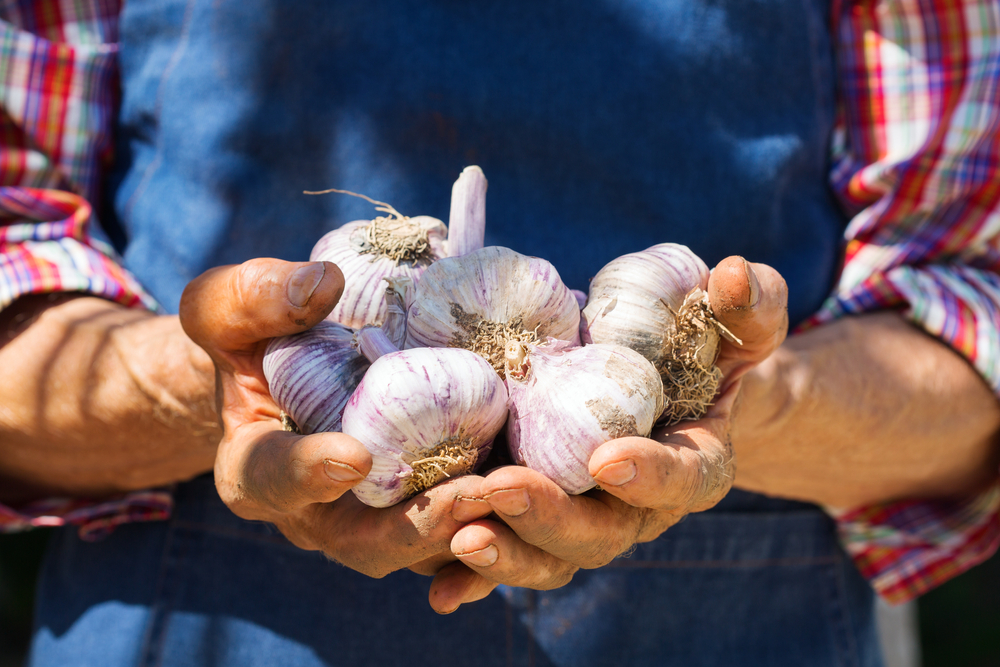
Image Source: Shutterstock.com
There’s something special about garlic. It stands bold in the kitchen, elevates meals, wards off blandness, and carries centuries of folklore on its papery shoulders. Yet, for all its culinary fame, garlic remains surprisingly misunderstood in the garden.
Many gardeners plant it too shallow, too late, or too casually—missing out on larger bulbs, richer flavor, and more resilient plants. But there’s a clever planting trick circulating quietly among seasoned growers, and once you learn it, your garlic harvest will never be the same.
The Trick Involves Planting Garlic With A “Cold Start”
Most people assume garlic should be planted when the soil is warm and friendly, but garlic actually thrives when it’s introduced to colder conditions. The trick is planting garlic before the first hard frost, allowing it to experience a brief chilling period in the soil. This sets off a chemical and developmental signal inside the clove, preparing it to multiply into a full, hearty bulb in spring. Without this cold exposure, garlic tends to form tight, underdeveloped heads with fewer cloves. When garlic gets the “cold start” treatment, it wakes up with a blueprint for growth already locked in.
Why Cold Exposure Makes Bigger Bulbs
Garlic is naturally wired to respond to seasonal shifts because it originated in climates where winters served as a natural reset. When cloves feel the drop in temperature, they interpret it as a cue: time to establish roots and prepare for vigorous spring expansion. This process is called vernalization, and it’s the same principle that helps tulips and peonies bloom. Gardeners who skip or shorten this cold period often wonder why their garlic looks more like onions pretending to be garlic. The cold exposure is the difference between “just garlic” and glorious garlic.
The Best Time to Plant for This Method
The ideal planting time is not when everything feels cozy, but when fall starts to firmly take hold. The soil should be cool, but not frozen—usually a few weeks before your regions first expected hard frost. This timing allows the cloves to settle in and initiate root development while avoiding premature sprouting above ground. If garlic sprouts fully before winter, those soft shoots can get damaged by cold snaps, resulting in weaker plants. Count backward from the first frost date, and that’s your sweet spot window.
How Deep to Plant for Maximum Growth
Most gardeners casually poke garlic into the soil and hope for the best, but depth matters more than you might think. Planting cloves about two to three inches deep provides insulation and stability, especially during winter freeze-thaw cycles. Too shallow, and the cloves risk frost damage or heaving upward during soil expansion. Too deep, and they may struggle to emerge or develop efficiently. A happy middle ground ensures garlic stays protected yet ready to burst upward when spring arrives.

Image Source: Shutterstock.com
Mulching Is the Unsung Hero of the Garlic Patch
Once you’ve planted your cloves, resist the urge to walk away without mulching—it’s one of the most important steps. Mulch acts like a cozy blanket that moderates soil temperature, holds moisture, and protects against harsh winter winds. Straw, shredded leaves, or grass clippings all work beautifully, but straw is often preferred for how lightly it rests on the soil. Without mulch, garlic faces a rougher winter and may become stressed, leading to smaller bulbs later. Mulching may seem simple, but it truly is the guardian of healthy garlic growth.
When Spring Comes, Let Garlic Do Its Thing
It’s tempting to fuss over garlic in early spring, but restraint is part of the magic here. As soon as temperatures rise, garlic begins shooting upward with focused energy, using all of the winter preparation you gave it. Avoid fertilizing too early or overwatering during this stage, as garlic prefers slow, steady progress rather than pampering. You’ll also want to watch for garlic scapes—the curly flower stems that appear later—which should be removed to redirect energy back into bulb development. Let garlic build momentum, and it will reward you generously.
The Difference at Harvest Time Is Stunning
Gardeners who use this trick are often amazed at how dramatically larger and more flavorful their garlic harvest becomes. The bulbs tend to be fuller, with cloves that are plump, aromatic, and easier to peel. The plants themselves appear stronger and more resilient to pests or disease. Once harvested and cured, this garlic stores beautifully, often outlasting garlic grown without the cold conditioning period. The improvement is so impressive that many gardeners never return to their old planting methods again.
Your Garlic Can Be Better Than Ever
Garlic may be humble, but it responds powerfully to thoughtful planting. Giving it a cold start, proper depth, and protective mulch sets the stage for robust growth and full-bodied flavor. With just a bit of timing and attention, your garlic patch can flourish like a seasoned gardener’s, even if you’re just starting out. Now that you know the trick, your next garlic harvest might be your best yet.
Have you tried this technique or discovered your own garlic-growing wisdom? Share your stories, insights, or questions in the comments below.
You May Also Like…
Why Garlic and Shallots Thrive When Planted Now
The Ultimate November Garden Checklist: Don’t Skip These Final Tasks
7 Tricks for Keeping Roses Blooming Longer
5 Old Wives’ Tales About Fall Gardening Debunked
Why Garlic Loves Being Planted Before Winter
Leave a Reply